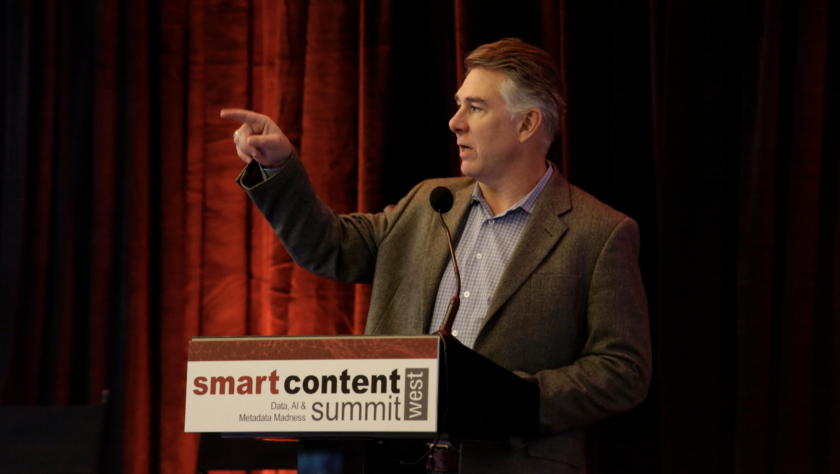Exclusives

Smart Content West: M&E Companies Must Embrace New Forms of Interactivity
Story Highlights
Interactivity keeps evolving and it’s important for media and entertainment companies to embrace new forms of interactive media and also find ways to measure viewer engagement, John Canning, chair of the Producers Guild of America (PGA) New Media Council, said Feb. 27 at the Smart Content Summit in Los Angeles.
“Years and years ago – for those of you that are old enough to remember, and there’s only a few of us left probably – we did try first-screen interactivity,” he told attendees during the session “Interactive Media: By The Numbers,” while taking a trip down memory lane to the days of WebTV and Microsoft TV.
He reminisced: “We did all those cool things on set-top boxes. We were going to rule the world. We were going to let everybody buy Jennifer Aniston’s sweater…. That didn’t work out so well.”
Then came the rise of the smartphone and “we all discovered that we could do interactivity that way” instead, he noted, adding: “It’s still not the best way to do it. But let’s face it. It was the way around all the other problems we had.”
But “what I’m excited about is we’re slowly getting back to first-screen interactivity,” he said. Many people are watching TV shows on a mobile device and “that is now becoming your first screen” instead of the TV, he pointed out. Tablets, smartphones and laptops are “no longer your second screen,” he said.
“My postulation is I’d like to get back to enabling” the use of a remote control — or “potentially voice activate — and make something happen and not require you to pull out another device,” he told the summit.
Moving on to social media, he noted that “used to be a thing that only younger people did, but it’s “now just the core fabric of what we do.”
About 70 percent of the U.S. population is “doing something on social media” now and it’s become hard to imagine doing any TV show or movie anymore without engaging consumers in conversation via a social media presence of some sort, he said, adding: “It is no longer a thing by itself, right? It is just what we do as a part of pushing our media out.” That provides a “base layer of interactivity” now – even if it’s just retweeting that some people are doing, he said.
“Web sites used to be novel – not anymore,” he said, underscoring the need for social media in addition to any web site presence when promoting a new TV show or movie.
He cited the findings of an eight-week interactive online campaign by FX for its TV show “American Horror Story” that was part of a marketing campaign to promote the most recent season, called “Cult.” Fans of the show were invited to join the “cult” via a Facebook Messenger bot and complete interactive video tasks every week to unlock content related to the season before it started, he noted.
Citing data that was released around that campaign, he said there were 500,000 Facebook messages generated and 9.1 million viewers watched the season premiere, making it the network’s second most-watched program of 2017.
“What they found is they had deep engagement – over 70 percent completion rate of all” eight episodes that were included, he said.
He also urged attendees to look at the Twitch live streaming video platform, even if video games don’t interest them because of the “huge population” of gamers who use it.
He explained: “These folks are doing something dramatically different with their audience…. They’re helping those people that are pushing the content make money. There’s a monetization layer into this. They’re getting up to 90 percent engagement by viewers on certain parts of those topics. So, it’s something to watch because they’re just building it from the ground up as a native part of what they’re doing and built into that audience. It isn’t giving you a TV show and then saying ‘I’m gonna wrap some interactivity around it’. It’s just a part of that show.”
Also significant is the rise of digital voice assistants, which he said he sees as “the rise of the ad-hoc home network.” Those devices are “insidiously just seeping into everybody’s homes,” he said, pointing to data showing the large acceptance rate they have among consumers, who indicated the devices are making their daily lives easier. “Predominantly, they’re playing music” now but the devices can do many other things, he noted, turning to the significance of being able to now change TV stations by voice control.
Voice-activated video searching, such as what can be done with Comcast’s X1 voice-activated remotes, is much easier than using electronic programming guides, which are “a pain in the ass,” he said, citing data showing X1 viewers are speaking into their remotes 11-15 times a week. The ability to request a TV show by voice is “insidious, it’s there and it’s just becoming a fabric of what we can do” now, he said.
He went on to say: “Everything is becoming interactive in what we do in one way or another,” so it’s no longer possible to make TV shows without any form of interactivity.
But also important, he added, is the ability to measure what viewers are doing – not only what they are watching, but what they’re doing while they’re watching. Measurement is “becoming more and more key,” he said.
Produced by the Media & Entertainment Services Alliance (MESA), in association with the Hollywood IT Society (HITS) and the Smart Content Council, Smart Content West was sponsored by Amazon Web Services, MicroStrategy, NeuLion, MarkLogic, SAP, Bob Gold & Associates, Ad-ID, DEG: The Digital Entertainment Group, and the Entertainment Merchants Association.









